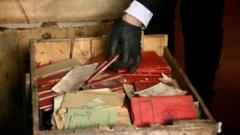Argentina's Supreme Court has uncovered crates filled with documents from Nazi Germany during a recent archival cleanup, revealing crucial pieces of history that had been hidden for decades.
Rediscovered Nazi Documents in Argentine Court Shed Light on Historical Secrecy

Rediscovered Nazi Documents in Argentine Court Shed Light on Historical Secrecy
Crates containing a trove of Nazi documents have been found in the basement of Argentina's Supreme Court, offering insights into the country's complex past with the Third Reich.
The unexpected discovery was made as workers prepared to move archival material from the Supreme Court's basement to a new museum. Among the items were wooden crates that had been overlooked, containing membership booklets and propaganda materials related to Nazi organizations.
Upon investigation, court officials learned these documents arrived in Argentina via 83 diplomatic pouches sent by the German embassy in Tokyo on June 20, 1941, aboard a Japanese steamship. The Argentine customs officials confiscated them after examining five pouches, discovering the Nazi materials inside.
The contents of the crates include photographs and membership booklets adorned with swastikas, intended to promote Adolf Hitler's ideology in Argentina during World War II. These documents have piqued the interest of historians, who believe they could reveal information about Nazi financial networks and their connections across borders.
The Argentine Supreme Court has reached out to the Buenos Aires Holocaust Museum to help inventory the materials. The documents, labeled as "personal effects" by the German embassy, raised suspicions among customs officials due to their large quantity.
The Argentine government, fearing it could compromise the country’s neutral position during the war, took action by seizing all 83 pouches in September 1941. However, the Supreme Court did not finalize a decision on their future until 1944, after Argentina severed ties with the Axis powers. Consequently, these crates remained untouched in the court's basement until their recent rediscovery.
After World War II, Argentina became a refuge for many prominent Nazis, including Adolf Eichmann and Josef Mengele. The findings highlight the nation's tumultuous relationship with its past, which was acknowledged by former President Fernando de la Rúa's formal apology in 2000 for the country’s harboring of Nazi war criminals.
Upon investigation, court officials learned these documents arrived in Argentina via 83 diplomatic pouches sent by the German embassy in Tokyo on June 20, 1941, aboard a Japanese steamship. The Argentine customs officials confiscated them after examining five pouches, discovering the Nazi materials inside.
The contents of the crates include photographs and membership booklets adorned with swastikas, intended to promote Adolf Hitler's ideology in Argentina during World War II. These documents have piqued the interest of historians, who believe they could reveal information about Nazi financial networks and their connections across borders.
The Argentine Supreme Court has reached out to the Buenos Aires Holocaust Museum to help inventory the materials. The documents, labeled as "personal effects" by the German embassy, raised suspicions among customs officials due to their large quantity.
The Argentine government, fearing it could compromise the country’s neutral position during the war, took action by seizing all 83 pouches in September 1941. However, the Supreme Court did not finalize a decision on their future until 1944, after Argentina severed ties with the Axis powers. Consequently, these crates remained untouched in the court's basement until their recent rediscovery.
After World War II, Argentina became a refuge for many prominent Nazis, including Adolf Eichmann and Josef Mengele. The findings highlight the nation's tumultuous relationship with its past, which was acknowledged by former President Fernando de la Rúa's formal apology in 2000 for the country’s harboring of Nazi war criminals.

















